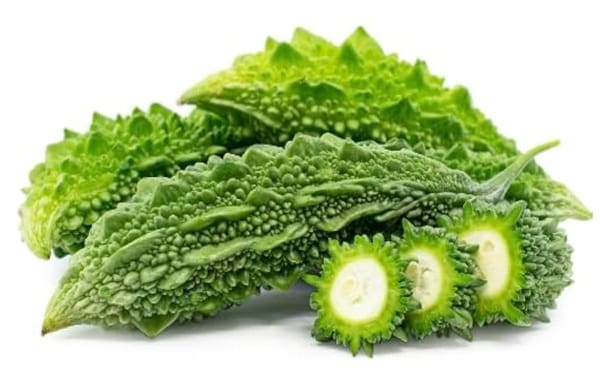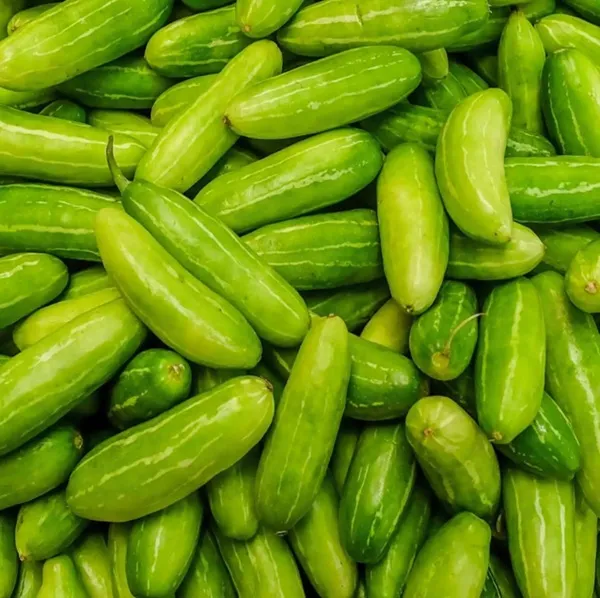Table of Contents
Bitter Melon (Gourd): A Comprehensive Guide
Introduction
Bitter melon (Momordica charantia), also known as bitter gourd, karela, or goya, is a tropical vine fruit celebrated for its sharp bitterness and medicinal properties. A member of the Cucurbitaceae family, it thrives in warm climates and is a staple in Asian, African, and Caribbean cuisines. This article explores its global varieties, nutritional benefits, cultivation practices, and culinary versatility.
Global Varieties & Colors
Bitter melon varies widely in shape, size, and bitterness:
- Indian (Small): 10–15 cm, spiky skin, deep green, intensely bitter.
- Chinese (Long): 20–30 cm, pale green, smoother bumps, milder bitterness.
- Hybrid (Taiwanese White): Lighter green to white, less bitter.
- Japanese (Goya): Bumpy, dark green, used in Okinawan dishes.
- Thai: Slim, bright green, crispy texture.
Ripe fruits turn orange-yellow but are typically harvested green.

Sensory Profile
- Smell: Earthy, herbaceous, with a faintly pungent edge.
- Flavor: Intensely bitter due to momordicin and charantin compounds.
- Texture: Crisp when raw, tender when cooked.
Nutrition & Health Benefits
- Calories: 17 kcal per 100g.
- Rich in: Vitamin C (84% DV), Vitamin A (44% DV), folate (17% DV), potassium, and fiber.
- Glycemic Index (GI): ~15–20 (very low), ideal for diabetics.
- Key Compounds: Charantin (hypoglycemic), polypeptide-p (insulin-like).
Health Benefits:
- Blood Sugar Regulation: Enhances glucose metabolism; studied for Type 2 diabetes management.
- Antioxidant Power: Fights free radicals, reducing oxidative stress.
- Immune Support: High vitamin C boosts immunity.
- Digestive Health: Fiber aids gut function; traditional remedy for parasites.
⚠️ Safety Note: Avoid excessive consumption during pregnancy due to potential uterine stimulation.
Cultivation Practices

- Climate: Tropical/subtropical (20–30°C/68–86°F); frost-sensitive.
- Soil: Well-drained loam/sandy soil with pH 5.5–6.7. Requires trellising for vine support.
- Growing Cycle: 55–100 days from seed to harvest.
Major Producers & Trade
- Top Producers: India, China, Philippines, Thailand, Bangladesh.
- Exporters: India (fresh), China (processed extracts), Thailand.
- Importers: USA, Canada, UAE, UK (Asian diaspora demand).
Diseases & Pests
- Powdery Mildew: White fungal patches; treat with sulfur spray.
- Fruit Flies: Larvae infest fruits; use neem oil or traps.
- Fusarium Wilt: Soil-borne fungus; rotate crops.
Home Farming & ROI
- Planting: Sow seeds 1 cm deep, 60–90 cm apart. Harvest when fruits are 10–15 cm long.
- Yield: 5–10 kg per plant. Farmers’ market prices: $3–6/lb (organic premium).
- ROI: High in regions with demand; low input costs but labor-intensive harvesting.
Culinary Uses
- Raw: Thinly sliced in salads (soak in saltwater to reduce bitterness).
- Cooked:
- Stir-Fried: With eggs, garlic, and soy sauce (Chinese bitter melon and egg).
- Stuffed: Minced meat or lentils in Indian bharwa karela.
- Soups: Filipino pinakbet or Thai kaeng liang.
- Juices/Teas: Blended with honey or ginger to mask bitterness.
- Quick Recipe: Bitter Melon Chips (slice thinly, bake with olive oil and paprika at 180°C/350°F).
Storage & Preservation
- Refrigerate: Whole in a plastic bag for 4–5 days.
- Freeze: Blanch slices for 2–3 minutes, dry, and freeze for 6–8 months.
- Pickling: Preserve in vinegar or brine for tangy condiments.
Byproducts & Innovations
- Supplements: Capsules for blood sugar management.
- Teas: Dried slices brewed for detoxification.
- Cosmetics: Extracts in anti-aging creams (antioxidant properties).
- Animal Feed: Non-marketable fruits repurposed.
Cultural Significance
- India: Revered in Ayurveda for detoxifying properties.
- Okinawa, Japan: Goya champuru (stir-fry) linked to longevity.
- Caribbean: Used in traditional remedies for infections.
Conclusion
Bitter melon’s sharp flavor and medicinal value make it a unique addition to global cuisines and wellness practices. While challenging for palates unaccustomed to bitterness, its health benefits and versatility in dishes—from stir-fries to teas—underscore its enduring appeal. Home gardeners and commercial growers alike can capitalize on its resilience and niche market demand.
Try This: For a balanced dish, stir-fry bitter melon with tofu, turmeric, and coconut, or blend into a smoothie with pineapple to counter bitterness.









